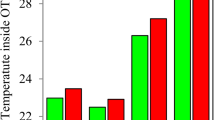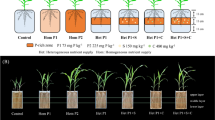Abstract
Background and aims
Maintaining nutrient supply, including phosphorus (P), is critical to ensure the adaptation of cropping systems to future elevated CO2 (eCO2) environments. There is much speculation about the role of sparingly soluble sources to supply plants with P so we tested the hypothesis that eCO2 increases plant’s ability to utilise P from sparingly soluble sources via affecting rhizosphere properties.
Methods
Chickpea and wheat were grown for 6 weeks in washed sand supplied with 40 mg P kg−1 as either readily soluble Ca(H2PO4)2 or sparingly soluble AlPO4 (Al-P), FePO4 or hydroxyapatite (HAP). Half plants were exposed to eCO2 (700 ppm) while the others to ambient CO2 (380 ppm).
Results
Elevated CO2 increased biomass production of both species but did not influence P concentration in plants, rhizosphere pH or Olsen P. Among the sparingly soluble P sources, HAP resulted in the maximum biomass and total P uptake in wheat and chickpea with wheat acquiring more P. Supply of nitrate, as compared to urea, to wheat decreased the uptake of P from HAP but increased it from Al-P.
Conclusion
Elevated CO2 does not specifically affect plant access to P from sparingly soluble P sources. Urea facilitates P acquisition from HAP whereas nitrate facilitates it from Al-P.




Similar content being viewed by others
References
Bertrand I, Hinsinger P, Jaillard B, Arvieu JC (1999) Dynamics of phosphorus in the rhizosphere of maize and rape grown on synthetic, phosphated calcite and goethite. Plant Soil 211:111–119
Betencourt E, Duputel M, Colomb B, Desclaux D, Hinsinger P (2012) Intercropping promotes the ability of durum wheat and chickpea to increase rhizosphere phosphorus availability in a low P soil. Soil Biol Biochem 46:181–190
Bloom AJ, Meyerhoff PA, Taylor AR, Rost TL (2003) Root development and absorption of ammonium and nitrate form the rhizosphere. J Plant Growth Regul 21:416–431
Bolland MDA, Wilson IR, Allen DG (1994) Effect of P-buffer capacity and P-retention index of soils on soil test-P, soil test P-Calibration and yield response curvature. Aust J Soil Res 32:503–517
Campbell CD, Sage RF (2002) Interactions between atmospheric CO2 concentration and phosphorus nutrition on the formation of proteoid roots in white lupin (Lupinus albus L.). Plant Cell Environ 25:1051–1059
Forde BG (2002) Local and long-rang signalling pathways regulating plant responses to nitrate. Annu Rev Plant Physiol Plant Mol Bio 53:203–224
Frossard E, Condron LM, Oberson A, Sinaj S, Fardeau JC (2000) Processes governing phosphorus availability in temperate soils. J Environ Qual 29:15–23
Gahoonia TS, Claassen N, Jungk A (1992) Mobilization of phosphate in different soils by supplied with ammonium or nitrate. Plant Soil 140:241–248
Geelhoed JS, Van Riemsdijk WH, Findenegg GR (1999) Simulation of the effect of citrate exudation from roots on the plant availability of phosphate adsorbed on goethite. Eur J Soil Sci 50:379–390
Ghannoum O, Searson MJ, Conroy JP (2006) Nutrient and water demands of plants under climate change. In: Newton PCD, Edwards G, Carran A, Niklaus P (eds) Agroecosystems in a changing climate. Advances in agroecology series. CRC Press, Boca Raton, pp 53–83
Hinsinger P (2001) Bioavailability of soil inorganic P in the rhizosphere as affected by root-induced chemical changes: a review. Plant Soil 237:173–195
Hinsinger P, Gilkes RJ (1996) Mobilization of phosphate from phosphate rock and alumina-sorbed phosphate by the roots of ryegrass and clover as related to rhizosphere pH. Eur J Soil Sci 47:533–544
Hinsinger P, Plassard C, Tang C, Jaillard B (2003) Origins of root-mediated pH changes in the rhizosphere and their responses to environmental constraints: a review. Plant Soil 248:43–59
Jin J, Tang C, Armstrong R, Sale P (2012) Phosphorus supply enhances the response of legumes to elevated CO2 (FACE) in a phosphorus-deficient Vertisol. Plant Soil 358:86–99
Jin J, Tang C, Armstrong R, Butterly C, Sale P (2013) Elevated CO2 temporally enhances phosphorus immobilization in the rhizosphere of wheat and chickpea. Plant Soil 368:315–328. doi:10.1007/s11104-012-1516-9
Lambers H, Shane MW, Cramer MD, Pearse SJ, Veneklaas EJ (2006) Root structure and functioning for efficient acquisition of phosphorus: matching morphological and physiological traits. Ann Bot-London 98:693–713
Loganathan P, Hedley MJ, Saggar S (1995) Liming effects of reactive phosphate rock: a laboratory evaluation. In: Date RA, Grundon NJ, Rayment GE, Probert ME (eds) Plant-soil interactions at low pH: principles and management. Kluwer Academic Publishers, Dordrecht, pp 641–645
Ma G, Rengasamy P, Rathjen AJ (2003) Phytotoxicity of aluminium to wheat plants in high-pH solutions. Aust J Exp Agr 43:497–501
Marschner P, Crowley D, Yang CH (2004) Development of specific rhizosphere bacterial communities in relation to plant species, nutrition and soil type. Plant Soil 261:199–208
Motomizu S, Wakimoto T, Toei K (1983) Spectrophotometric determination of phosphate in river waters with molybdite and malachite green. Analyst 108:361–367
Olsen SR, Dean LA (1965) Phosphorus. In: Black CA (ed) Methods of soil analysis. Soil Science Society of America, Wisconsin, pp 1044–1047
Pearse SJ, Veneklaas EJ, Cawthray G, Bolland MDA, Lambers H (2006) Triticum aestivum shows a greater biomass response to a supply of aluminium phosphate than Lupinus albus, despite releasing fewer carboxylates into the rhizosphere. New Phytol 169:515–524
Pearse SJ, Veneklaas EJ, Cawthray G, Bolland MDA, Lambers H (2007) Carboxylate composition of root exudates does not relate consistently to a crop species’ ability to use phosphorus from aluminium, iron or calcium phosphate sources. New Phytol 173:181–190
Raghothama KG (1999) Phosphate acquisition. Ann Rev Plant Phys 50:665–693
Reuter DJ, Robinson JB (1997) Plant analysis: an interpretation manual, 2nd edn. CSIRO Publishing, Collingwood
Richardson AE, Hocking PJ, Simpson RJ, George TS (2009) Plant mechanisms to optimise access to soil phosphorus. Crop Pasture Sci 60:124–143
Riley D, Barber SA (1971) Effect of ammonium and nitrate fertilization on phosphorus uptake as related to root-induced pH changes at root-soil interface. Soil Sci Soc Am Pro 35:301–306
Steel RG, Torrie JH (1980) Principles and procedures of statistics: a biometrical approach, 2nd edn. McGraw-Hill, New York
Stöcklin J, Körner C (1999) Interactive effects of elevated CO2, P availability and legume presence on calcareous grassland: results of a glasshouse experiment. Funct Ecol 13:200–209
Tang C, McLay CDA, Barton L (1997) A comparison of proton excretion of twelve pasture legumes grown in nutrient solution. Aust J Exp Agr 37:563–570
Turner BL, Condron LM, Richardson SJ, Peltzer DA, Allison VJ (2007) Soil organic phosphorus transformations during pedogenesis. Ecosystems 10:1166–1181
Wang X, Tang C, Guppy CN, Sale PWG (2010) Cotton, wheat and white lupin differ in phosphorus acquisition from sparingly soluble sources. Environ Exp Bot 69:267–272
Wang X, Guppy CN, Watson L, Sale PWG, Tang C (2011) Availability of sparingly soluble phosphorus sources to cotton (Gossypium hirsutum L.), wheat (Triticum aestivum L.) and white lupin (Lupinus albus L.) with different forms of nitrogen as evaluated by a 32P isotopic dilution technique. Plant Soil 348:85–98
Watt M, Evans JR (1999) Linking development and determinacy with organic acid efflux from proteoid roots of white lupin grown with low phosphorus and ambient or elevated atmospheric CO2 concentration. Plant Physiol 120:705–716
Yuen SH, Pollard AG (1954) Determination of nitrogen in agricultural materials by the Nessler Reagent. II. Micro-determination of plant tissue and soil extracts. J Sci Food Agr 5:364–369
Zoysa AKN, Loganathan P, Hedley MJ (1998) Effect of forms of nitrogen supply on mobilisation of phosphorus from a phosphate rock and acidification in the rhizosphere of tea. Aust J Soil Res 36:373–387
Acknowledgments
This research was supported by an Australian Research Council Linkage Project (LP100200757) in partnership with the Department of the Environment and Primary Industries (Victoria).
Author information
Authors and Affiliations
Corresponding author
Additional information
Responsible Editor: Tim Simon George.
Rights and permissions
About this article
Cite this article
Jin, J., Tang, C., Hogarth, T.W. et al. Nitrogen form but not elevated CO2 alters plant phosphorus acquisition from sparingly soluble phosphorus sources. Plant Soil 374, 109–119 (2014). https://doi.org/10.1007/s11104-013-1870-2
Received:
Accepted:
Published:
Issue Date:
DOI: https://doi.org/10.1007/s11104-013-1870-2




